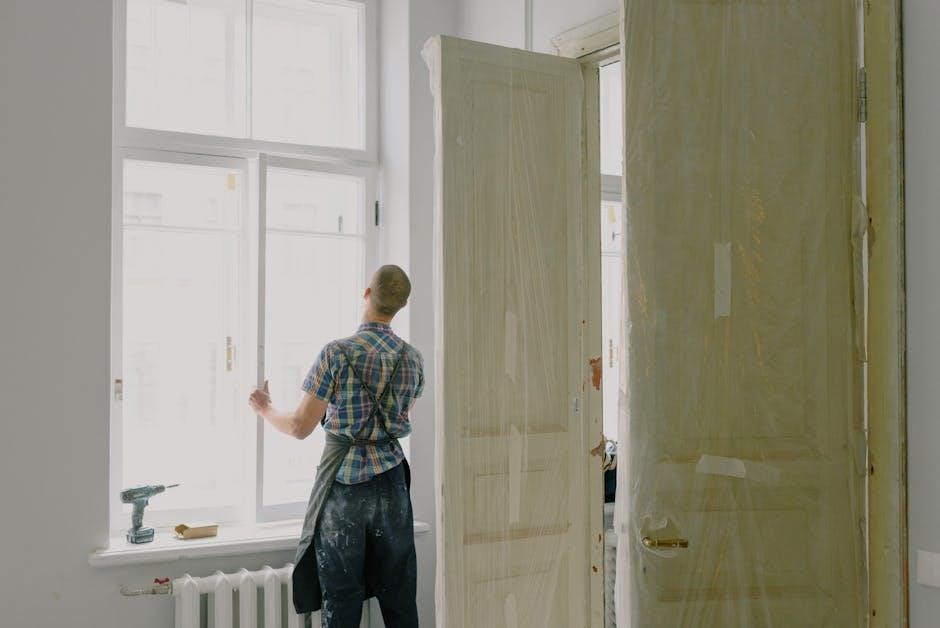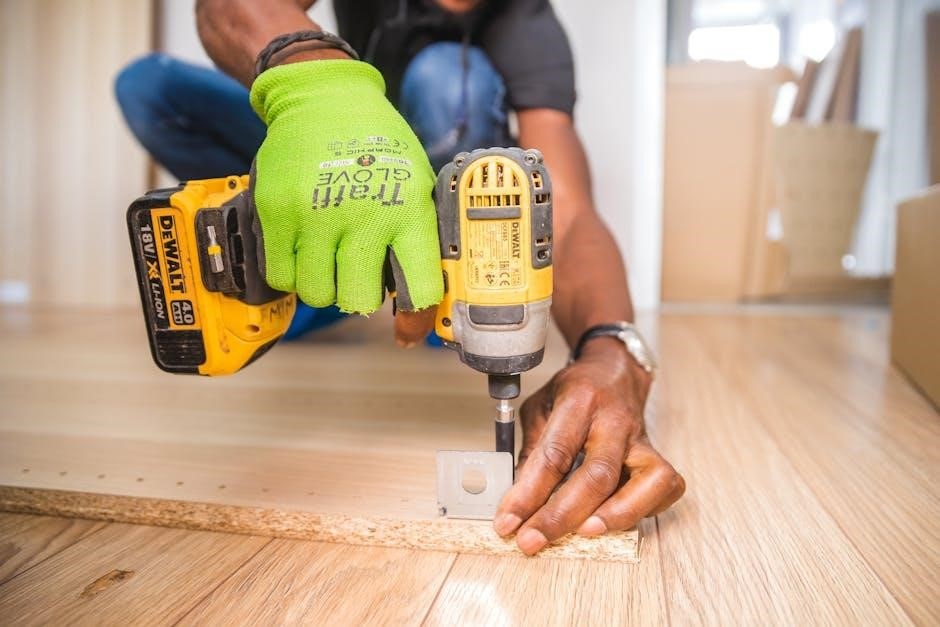
The MHK2 Remote Controller is a key component of Mitsubishi Electric’s RedLINK series, designed to control and monitor ducted systems efficiently; It integrates seamlessly with Kumo Cloud and the Kumo Touch app for remote operation. This controller offers advanced features, including a built-in thermistor and compatibility with various indoor units. The MHK2 kit includes the MRCH2 controller, MIFH2 receiver, and MRC2 cable, ensuring comprehensive control over heating and cooling systems. Refer to the installation manual for detailed setup instructions and operational guidelines.
1.1 Overview of the MHK2 System
The MHK2 system is a state-of-the-art remote controller designed for Mitsubishi Electric ducted systems, enabling seamless control and monitoring through wireless interfaces like Kumo Cloud. It comprises the MRCH2 controller, MIFH2 receiver, and MRC2 cable, ensuring efficient communication between system components. The MHK2 features a built-in thermistor for precise temperature sensing and integrates with the Kumo Touch app for remote operation, ensuring optimal performance and user convenience.
1.2 Purpose of the Installation Manual
This manual provides a comprehensive guide for installing, configuring, and operating the MHK2 Remote Controller. It outlines essential safety precautions, installation steps, and setup requirements to ensure proper functionality. The manual also covers troubleshooting and maintenance tasks, helping users optimize system performance. By following the guidelines, users can safely and effectively integrate the MHK2 with Mitsubishi Electric indoor units for seamless control and monitoring.
System Components and Accessories
The MHK2 system includes the MRCH2 controller, MIFH2 receiver, and MRC2 cable, ensuring seamless communication and control. Additional accessories like mounting hardware and connectors are provided for easy installation.
2.1 Key Components of the MHK2 Kit
The MHK2 kit comprises essential components for seamless operation. The MRCH2 controller serves as the central command unit, while the MIFH2 receiver ensures reliable signal transmission. The MRC2 cable facilitates secure connections, and the remote control allows for convenient system management. These components are designed to work in harmony, providing precise control over Mitsubishi Electric indoor units for optimal performance and efficiency.
2.2 Required Tools and Materials
To install the MHK2 Remote Controller, you will need a Phillips screwdriver, a drill with bits, and cable ties for secure connections. Ensure you have the MRC2 cable, mounting hardware, and power supply units. Safety gear like gloves and goggles is recommended. Refer to the installation manual for specific tools and materials, as additional items may be required based on your system configuration and installation environment.
Installation Steps
Install the MHK2 Remote Controller by first preparing the site and tools, then mounting the components, connecting wires, and configuring settings. Follow the manual for detailed guidance.
3.1 Pre-Installation Checklist
Before installing the MHK2 Remote Controller, ensure you have all required tools and materials, including the MRCH2 controller, MIFH2 receiver, MRC2 cable, and power supply. Verify compatibility with your Mitsubishi Electric indoor unit and check for any firmware updates. Ensure power is disconnected to prevent electrical shock. Review the installation manual thoroughly and confirm the installation site meets all safety and technical requirements.
3.2 Step-by-Step Installation Guide
Connect the MRCH2 controller to the MIFH2 receiver using the MRC2 cable. Mount the receiver near the indoor unit, ensuring proper alignment. Secure the MHK2 Remote Controller to the wall or desired location. Connect the power supply to the receiver and controller. Ensure all wires are tightly connected and routed safely. Power on the system and test the remote controller functionality to confirm successful installation.

Commissioning the MHK2
Commissioning involves configuring the MHK2 Remote Controller to communicate with Mitsubishi Electric indoor units. Connect the controller, power it on, and test functionality. Ensure proper operation and settings before finalizing the setup. Refer to the installation manual for detailed commissioning steps and troubleshooting tips. Verify communication and operation to complete the process successfully.
4.1 Initial Setup and Configuration
Begin by connecting the MHK2 Remote Controller to the Mitsubishi Electric indoor unit. Ensure the Wireless Interface 2 is installed and configured. Power off the system before starting. Follow the manual’s instructions to attach the MRCH2 controller, MIFH2 receiver, and MRC2 cable. Configure settings using the Kumo Touch app or Kumo Cloud. Test communication and operation to confirm proper setup. Refer to the MHK2 Installation Manual for detailed steps and ensure all safety precautions are followed during the process to avoid equipment damage or electrical hazards.
4.2 Testing the Device Connection
After initial setup, verify the MHK2 connection to the Kumo Cloud and indoor unit. Use the Kumo Touch app to ensure communication is established. Check for error messages and test operational modes. Confirm remote functionality by adjusting settings via the app. Ensure the Wireless Interface 2 is properly configured. Refer to the MHK2 Installation Manual for detailed testing procedures to confirm a stable and functional connection.

Wiring and Connections
Connect the MRCH2 controller, MIFH2 receiver, and MRC2 cable as per the wiring diagram. Ensure all connections are secure and comply with the installation manual. Always disconnect power before starting work to avoid electrical hazards.
5.1 Understanding Wiring Diagrams
The wiring diagrams provided in the MHK2 installation manual are essential for proper setup. They detail connections between the MRCH2 controller, MIFH2 receiver, and MRC2 cable. Ensure all terminals are correctly matched to avoid errors. Refer to the manual for color-coded wires and specific instructions, ensuring compliance with safety standards to prevent electrical hazards and equipment damage. Always follow the manufacturer’s guidelines for a secure installation.
5.2 Connecting the Components
Begin by connecting the MRCH2 controller to the MIFH2 receiver using the MRC2 cable. Ensure correct terminal connections as per the wiring diagram. Attach the receiver to the indoor unit’s control board securely. Verify all wire connections for tightness and accuracy. Connect the built-in thermistor or external sensor to ensure precise temperature control. Finally, link the controller to the wireless interface for Kumo Cloud integration, following the manual’s instructions carefully.
Configuration Settings
Configure operation modes, advanced features, and settings like auto-change from heat to cool. Refer to the manual for detailed instructions on optimizing performance and functionality.
6.1 Setting Up Operation Modes
Setting up operation modes on the MHK2 allows customization of system behavior. Choose from modes like Heating, Cooling, or Auto to match your climate needs. The Auto mode automatically switches between heating and cooling based on the set temperature. Use the Kumo Touch app or the remote controller to configure these settings. Ensure the system is commissioned correctly before selecting operation modes for optimal performance. Refer to the installation manual for step-by-step guidance on configuring these modes effectively.
6.2 Configuring Advanced Features
The MHK2 Remote Controller offers advanced features like scheduling, smart sensors, and energy-saving modes. Use the Kumo Touch app to enable these settings, optimizing performance and efficiency. Advanced features can be configured during initial setup or adjusted later. Ensure compatibility with your system by following the installation manual’s guidelines for feature activation. Proper configuration ensures enhanced functionality and energy efficiency for your Mitsubishi Electric system.
Troubleshooting Common Issues
Common issues include connectivity problems and error codes. Check connections, power cycle the device, and ensure proper signal strength. Refer to the manual for detailed solutions.
7.1 Diagnosing Connection Problems
Connection issues often stem from weak signal strength or faulty wiring. Check the wireless interface and ensure all cables are securely connected. Verify that the MHK2 controller is properly paired with the indoor unit. Consult the installation manual for troubleshooting steps, including resetting the controller or updating firmware to resolve connectivity errors effectively.
- Verify signal strength and wiring integrity.
- Check for proper pairing between components.
- Refer to the manual for reset and firmware update procedures.
7.2 Resolving Operational Errors
Operational errors can often be resolved by checking error codes and performing a power cycle. Ensure the MHK2 controller is correctly configured and paired with the indoor unit. Verify that operation modes and settings align with the installation manual. If issues persist, consult the troubleshooting section or contact Mitsubishi Electric support for assistance.
- Check error codes and perform a power cycle.
- Verify configuration and pairing with the indoor unit.
- Consult the manual or contact support for unresolved issues.
Safety Precautions and Maintenance
Disconnect power before servicing. Avoid exposing components to moisture or extreme temperatures. Regularly clean and inspect sensors and wiring for optimal performance and safety.
8.1 Essential Safety Measures
Always disconnect power before starting installation or maintenance to prevent electrical shock. Ensure the system is grounded properly. Use appropriate tools and follow the manufacturer’s guidelines. Keep the controller and sensors away from direct sunlight and moisture. Regular inspections of wiring and connections are crucial for safe operation. Refer to the manual for detailed safety protocols. Ensure all precautions are strictly followed to avoid equipment damage and personal injury.
8.2 Regular Maintenance Tasks
Regularly clean the remote controller and sensors to ensure accurate operation. Inspect wiring connections for damage or wear. Replace batteries in the remote when necessary. Check for firmware updates to maintain optimal performance. Ensure proper airflow by cleaning filters and vents. Schedule periodic checks of thermistor accuracy and system calibration. Refer to the manual for detailed maintenance procedures to prolong system lifespan and reliability.

Integration with Wireless Interfaces
Integrate the MHK2 with wireless interfaces like Kumo Cloud for remote control via the Kumo Touch app. Ensure a stable connection by using a Wireless Interface 2 for seamless operation.
9.1 Connecting to Kumo Cloud
To connect the MHK2 to Kumo Cloud, ensure a Wireless Interface 2 is installed. Follow the installation manual to link the device to your network. Access the Kumo Cloud platform and register your MHK2 controller. Ensure stable internet connectivity and proper network configuration for seamless remote monitoring and control via the Kumo Touch app. Refer to the manual for detailed pairing instructions.
9.2 Using the Kumo Touch App
The Kumo Touch app enables remote monitoring and control of your MHK2 system. Use the app to adjust operation modes, set schedules, and monitor performance. Notifications alert you to system changes or issues. Ensure your MHK2 is connected to Kumo Cloud and the app is installed on your iOS or Android device. Refer to the installation manual for app setup and feature customization details.

Best Practices and Manufacturer Recommendations
Always follow Mitsubishi Electric’s guidelines for installation and operation. Regularly maintain the system and use genuine parts. Refer to the manual for optimal performance and safety.
10.1 Following Installation Guidelines
Strictly adhere to the MHK2 installation manual to ensure proper setup and functionality. Verify all connections before powering up and follow safety precautions to avoid electrical hazards. Use only Mitsubishi-approved tools and materials. Double-check wiring diagrams and configurations to maintain system integrity. Regularly update firmware and software for optimal performance. Always test connections post-installation to ensure reliability and efficiency.
10.2 Adhering to Manufacturer Advice
Always follow Mitsubishi Electric’s guidelines for the MHK2 Remote Controller to ensure optimal performance and safety. Refer to the MHK2 Installation Manual for specific instructions and configuration details. Use only Mitsubishi-approved tools and materials to avoid compatibility issues. Consult the operation manual for operational guidelines and FAQs for troubleshooting common issues; This ensures compliance with manufacturer standards and maintains system reliability. Regular updates and maintenance are crucial for sustained functionality.